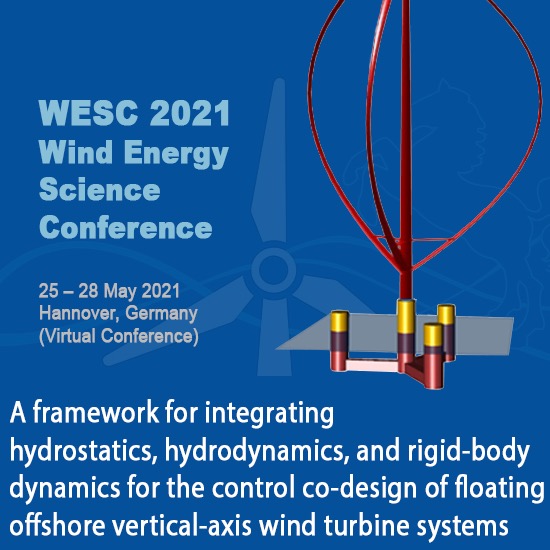
Publication Information
- Presented by: Yong Hoon Lee
- Authors: Yong Hoon Lee, Sung-Youn Boo, and James T. Allison
- Title: A framework for integrating hydrostatics, hydrodynamics, and rigid-body dynamics for the control co-design of floating offshore vertical-axis wind turbine systems
- Conference: Wind Energy Science Conference (WESC 2021)
- Links: [BIBTEX], [ABSTRACT]
Abstract
Offshore wind at deep-water regions is a large energy source that has not yet been developed in the United States. The major challenges in extracting this large amount of potential wind energy include the impracticality of conventional fixed foundations in the deep-water sites and the high installation and maintenance cost of floating platforms. Developing highly efficient floating offshore wind turbines (FOWTs) with a low-cost floating platform can be a key to resolve these challenges, and vertical-axis wind turbines (VAWTs) have advantageous characteristics for reducing cost when applied to the floating platforms. Here, we present progress for the ongoing development of an integrated framework for designing floating offshore vertical-axis wind turbine systems. The role of this framework in the development of the floating offshore vertical-axis wind turbine system is to provide design knowledge created by utilizing a system-level control co-design (CCD) problem to inform subsystem-level decision-making processes; based on this system-level design knowledge, higher-fidelity design activities are performed that can account approximately for system interactions and design couplings. This framework aims to achieve a reduced levelized cost of energy (LCOE) while satisfying structural integrity in wet tow conditions, design load cases (DLCs), and survival load case (SLC) (American Bureau of Shipping, 2013), using a surrogate model-based nested CCD approach. This design optimization framework integrates multidisciplinary simulation models, including hydrostatic stabilities based on open-source software, meshmagick (Rongere, 2020), floating-body hydrodynamics based on open-source software, capytaine (Ancellin and Dias, 2019), and a simplified lower-order dynamic model of six degree-of-freedom rigid body plus one additional degree of freedom for VAWT rotor dynamics and control (Griffith et al., 2018). The framework is capable of modeling arbitrary floating offshore vertical-axis wind turbine system configurations, enabled by an automated geometric variable manipulator and mesh generator customized for the tension-leg platforms (TLPs). A multi-level adaptive surrogate model-based optimization algorithm is also implemented in the framework to support design studies efficiently with limited computing resources.